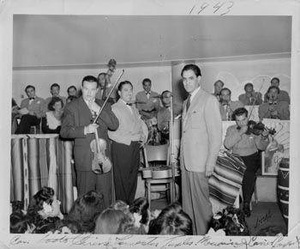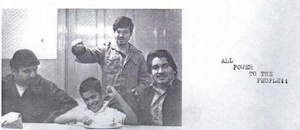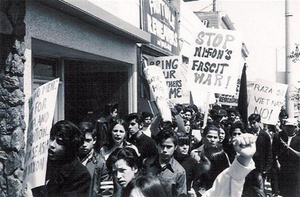 Map of Rancho San Antonio
Map of Rancho San Antonio Peralta hacienda in the Fruitvale District
Peralta hacienda in the Fruitvale District Peralta family at the Peralta Hacienda in Oakland
Peralta family at the Peralta Hacienda in Oakland
Early History
The Latino Hispanic Chicano Mexican history of Oakland begins in the 1770s during the Spanish colonization of California. The Oakland area and much of the surrounding territory was awarded to Spanish soldier Luís María Peralta as part of a large land grant by the last Spanish governor of California, Pablo Vicente de Solá, on August 3, 1820. The land was named Rancho San Antonio (California Historical Landmark #246), and included the lands that are now the cities of San Leandro, Oakland, Alameda, Emeryville, Albany and Piedmont. The following year, Mexico gained its independence from Spain, and California became Mexican territory. The Mexican-American War began in 1846, Alta California was ceded to the United States under the Treaty of Guadalupe Hidalgo in 1848, and on September 9, 1850, California became the 31st U.S. state. Soon thereafter, the Peraltas lost their land by purchase, theft and legal duress to Americans during the Gold Rush.
 Star Theater La Estrella on Market st corner with 7th st
Star Theater La Estrella on Market st corner with 7th st La Ideal Latin Music store was located on 7th st near Brush st
La Ideal Latin Music store was located on 7th st near Brush st The original La Bourinquena Mexican grocery store
The original La Bourinquena Mexican grocery store
Between the 1910s and 50s, West Oakland became home to a thriving Latino community that was majority Mexican, many fleeing the Mexican Revolution, and included many Cubans, Central Americans and Puerto Ricans. Many of those Puerto Ricans immigrated from Hawaii after laboring in the sugar plantations there.
A number of community members took jobs with the Southern Pacific railroad, as longshoremen, or as workers in canneries and factories. Some people worked in blue-collar jobs as machinists and auto mechanics. Other people ran small home-grown businesses, including small-scale food production. Some women ran boarding houses for young men who had come to labor, providing them with warm meals and laundry service. Important cultural centers included La Estrella (The Star) (1930s), a Spanish-language theater, as well as music and dance halls including Sweet's Ballroom which had Sunday Tardeada parties organized by Guadalupe Carlos. Musicians organized local orquestras like Los Caballeros, Merced Gallegos Band, and the Pete Escovedo Band. There were 3 different Spanish-language Catholic churches at that time and a Catholic social service organization Saint Mary's which was one of the first Catholic churches to offer mass in Spanish. Many Mexican Latino owned businesses began opening up around 7th Street to cater to the growing Mexican population. Mi Rancho and La Bourinquena were the first Mexican grocery stores in Oakland. Swans and Housewives Market began having Mexican owned stands and sold Mexican foods. Restaurants like Mexicali Rose, La Chapala and Enchilada Shop opened. There was a Mexican record store called La Ideal and la Ciudad de Mexico offered local Latinos music from Latin America. There were also several Mexican-owned pharmacies in the area.
The heart of the Mexican Latino community was around 7th st: 3rd, 4th, 5th and 6th streets, and Market Street, Filbert Street and myrtle Street and around Brush, and Clay near 7th and also in the South Prescott area. A radio show started by Ramon Martinez called "The South American Way" catered to the growing Latino community and was broadcast on KLA.
As the community grew, various Mexican and Latin American celebrations and festivals were organized. For example, Cinco de Mayo was celebrated at the New Century Community Center in West Oakland. In 1946 Ramon Martinez organized one of the first City-sponsored Cinco de Mayo celebrations at the Oakland Auditorium. Many other celebrations like Mexican Independence and even Dia de los Muertos were organized at community centers and at local schools and churches by the old West Oakland community.
 Mi Rancho Oakland's first Mexican Grocery store on 7th st
Mi Rancho Oakland's first Mexican Grocery store on 7th st Velazquez Family: their Restaurant the Enchilada shop on 7th st near Castro st
Velazquez Family: their Restaurant the Enchilada shop on 7th st near Castro st Guadalupe Carlos and Xavier Cougat Tardeada Mexican Parties at Sweets Ballroom.
Guadalupe Carlos and Xavier Cougat Tardeada Mexican Parties at Sweets Ballroom. Ramon Martinez and los Caballeros was one of the first Latin Music Groups in Oakland,
Ramon Martinez and los Caballeros was one of the first Latin Music Groups in Oakland,
WWII and Post-War Years
World War II brought many workers to Oakland to fill in the labor shortages, especially African Americans from the South and white workers from the South and Midwest. Many Mexican and Latino workers also came to Oakland to fill labor shortages. In the 1940's during World War II the Latino community grew as Mexican Americans from the Southwestern United states, especially New Mexico, Texas and Colorado settled in both West Oakland and East Oakland to work in wartime industries. 5000 Mexican Braceros came to Oakland to work in the West Oakland Southern Pacific Railroad yard and various other industrial and ship yard jobs.
 Bracero Workers Southern Pacific Railroad yard in West Oakland.
Bracero Workers Southern Pacific Railroad yard in West Oakland. Braceros at work in West Oakland Southern Pacific Rail yard.
Braceros at work in West Oakland Southern Pacific Rail yard.
Racial problems also grew during the war years. Harassment of Latino workers by Oakland Police was common. Oakland had its own version of the infamous Zoot Suit Riots on June 11, 1943. Two Mexican shipyard workers wearing Zoot Suits were arrested on Eighth and Washington after a fight with sailors. Also in November, 1943 there was a brawl in Alameda that was between Oakland Pachucos and a gang calling themselves "The Okies." In February, 1944 a huge brawl and riot happened on Telegraph in downtown Oakland between Mexican and Pachucos against sailors and soldiers during a dance. Several people got stabbed and injured and the Navy put West Oakland and downtown out of bounds for servicemen.
 Zoot suit riot on Telegraph ave February 1944
Zoot suit riot on Telegraph ave February 1944 Two Zoot suiters arrested after fight with service men in June 11 1943
Two Zoot suiters arrested after fight with service men in June 11 1943
Because Latinos were counted as white, it is unknown how big the population grew. Census records from 1950 shows the Latino population was roughly 23,729 or 7 percent of the population (whites with Spanish surnames) .
In the 1950s and 60s people in the Latino community started forming community and political organizations, such as the: Orden Fraternal de los Hijos de Puerto Rico (Fraternal Order of the Sons of Puerto Rico), the Mexican Organization for Pro-Patriotic Festivities, the Mexican-American Political Association, the Spanish-speaking Unity Council and the Comite de Latinoamericanos de West Oakland (West Oakland Latin American Committee). At this time, there were high poverty rates amongst the Latino and African-American populations of West Oakland. Latino community groups organized in response, demanding for greater job opportunities. It was also around this time in the Mid 1950's that Cesar Chavez began coming to Oakland. Though he lived in San Jose, he came to help organize with the community service organization at Saint Elizabeth Catholic Church in East Oakland.
 Cinco de mayo celebration at New Century community center in West Oakland 1944
Cinco de mayo celebration at New Century community center in West Oakland 1944
Beginning in the Mid 1950’s much of West Oakland was destroyed after then Highway 17 (now I-880 or the Nimitz Freeway) was built. Many homes and businesses were destroyed to build the the Cypress Viaduct and the rest of the Nimitz Freeway. Also Urban Renewal like the destruction of the area around Market street and 7th street was destroyed to make way for the Acorn High Rise apartments. This Urban Renewal of West Oakland continued into the 1960’s with the construction of BART and the construction of the Main Post Office Building on 1675-7th Street. Many African American and Hispanic families were displaced out of West Oakland by these projects. Oakland's first Latino community in West Oakland was completely destroyed. This forced many Latinos to relocate to the Fruitvale district, San Antonio, Melrose, and other parts of East Oakland. African Americans also relocated to East Oakland as well especially the Elmhurst district and surrounding areas. With the destruction of West Oakland the old Mexican Latino community was literally torn down, destroyed and wiped out. Most people lost their homes and got very little in compensation to move. It was the end of an era of both the Mexican community of West Oakland and the Harlem of the West.
1960s to 1980s
As the destruction of West Oakland began in the 1950's and continued on through the 1960's, many Mexican and Latino displaced residents of West Oakland began moving to East Oakland especially to the Fruitvale district and into the community known as Jingletown(Kennedy Tract) and places like San Antonio, Melrose and other Parts of East Oakland.
The community began to organize itself in East Oakland, especially around poverty and lack of services in the community. One of the first organizations to form was the Unity Council in 1964, at the time called Spanish Speaking Unity Council. They formed as a means of combating poverty in the Latino community. The Spanish Speaking Citizens' Foundation began in 1965 as a community center and a service center for the growing Latino Community in East Oakland. The Community Service Organization(CSO) formed a Oakland Chapter based out of the Fruitvale district. Notable members were Cesar Chavez and Bert Corona.
In late 60's there were growing problems in the Latino community such as lack of good schools, lack of adequate services, bad housing due to slumlords and a growing problem in drug addiction amongst Latino youth. Police brutality at the hands of the Oakland Police was creating huge frustration in the community. On February 5th, 1968 a 23 year old Fruitvale resident named Charles (Pinky) Debaca was shot and killed on 35th Ave in East Oakland by OPD. This murder brought on a very radical response in the community. At the time, the Chicano Movement had begun in the Southwest. These young Mexican Americans were fighting for civil rights and self determination. Oakland Latinos quickly began a local version of the Chicano Movement. One of the first groups was Latino United for Justice. They organized to make sure Oakland Police and the Mayor brought the officer who killed Charles De Baca on charges of murder and get him fired from OPD. Another organization that formed was the Chicano Revolutionary Party (CRP). Formed by young Chicano militants who where working with the Black Panthers who had formed a few years earlier in North Oakland, the CRP began doing armed patrols in the Fruitvale district and also had several free breakfast programs that the Black Panthers helped organize as well as a community newspaper called "La Chispa"
 Chicano Revolutionary Party
Chicano Revolutionary Party Chicano Revolutionary Party Free Breakfast Program
Chicano Revolutionary Party Free Breakfast Program
The Brown Berets, a Chicano militant organization from East Los Angeles, had also formed a chapter in Oakland. They started doing patrols and security for Chicano events and had a free breakfast program in East Oakland.
 Bobby Seale Reies Tijerina and the Oakland Brown Berets in Defremery Park 1968
Bobby Seale Reies Tijerina and the Oakland Brown Berets in Defremery Park 1968
Chicano youth in the Fruitvale district and in East Oakland began organizing against the Vietnam War. A high number of Black and Latino youth were being drafted. An organization called Frente Liberacion del Pueblo began organizing youth in Jingletown. On May 13, 1970 they organized a mass walk out of Chicano students. Chicano students from Oakland schools including Fremont High, Castlemont High, Oakland High, and Oakland Tech walked out against the Vietnam War and the draft. Many kids were bussed from other schools to the Fairfax Theater on Foothill Blvd where the students watched a documentary about the Vietnam War. The students then marched to the Fruitvale District, had a rally at Sanborn Park (now Josie De La Cruz park), then marched to Downtown Oakland to the Army Induction Center where they held a huge rally. According to some people there were about 1000 or more students shouting "Raza si, Guerra no." In july 26,1970 an organization calling itself "La Raza Unida Moratorium" organized the Chicano Moratorium in Oakland against the Vietnam war. About 2000 protesters marched from Jingletown to San Antonio Park where a big rally was held. The featured speaker was Rodolfo Corky Gonzales, a very influential Chicano radical from Denver, Colorado.
 Chicano Student walk out Anti War March May 13 1970
Chicano Student walk out Anti War March May 13 1970  Chicano Moratorium July 26 1970.
Chicano Moratorium July 26 1970.
The Chicano Movement had opened up the doors to tremendous changes in the community. In 1971 Chicano medical students helped open a Free Clinic in the Fruitvale district to serve the needs of the Latino Community who lacked a good health clinic. This clinic was La Clinica de la Raza. Chicanos also demanded that the School Board open up schools whose specialty was the help serve Latino students, especially when it came to teaching Latino and Chicano history and bilingual education. La Escuelita, Centro Infantil and Emiliano Zapata Street Academy were formed to satisfy the lack of Chicano-oriented schools. Theater groups like Teatro Triste began doing shows around Oakland based on many issues including drug addiction and oppression against Latinos. Festivals were organized like Dia de la Raza, also known as Dia Del Barrio, which was a festival that was held in Sanborn Park (now Josie de la Cruz Park).
Chicanos and Latinos began organizing politically as well during the Chicano Movement era. La Raza Unida party, a Chicano controlled political party that originated in Crystal City, Texas, organized a chapter in Oakland. They ran several candidates for City Council and for the Oakland School Board and the Peralta Board of Trustees. Although they never won an election, they made a huge mark and also opened doors for future Latinos in politics in Oakland. In 1972 a coalition of Blacks, Chicanos and progressive whites helped put Joe Coto into the city council representing Fruitvale and San Antonio districts. He was the first Latino Chicano city council member in Oakland's history. In the 1976 election two Latinos ran for Mayor Joe Coto and Hector Reyna both lost to Lionel Wilson, Coto received a high vote Margin.
On June 11, 1976, a 27 year old Chicano named Jose Barlow Benavidez was shot and killed by OPD in the Melrose area. This killing sparked mass protest in Oakland against police brutality. Chicanos and blacks organized to bring justice to Benavidez family.
1990s to 2000s
Link



